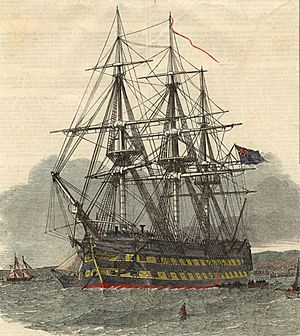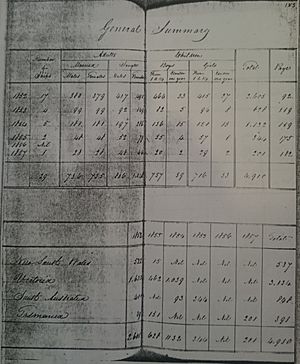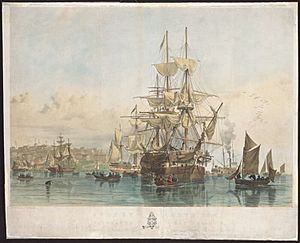Highland and Island Emigration Society facts for kids

The Highland and Island Emigration Society was a charity group. It was created to help people move from Scotland to other countries. This was seen as a way to solve the problems caused by the Highland Potato Famine.
Between 1852 and 1857, the Society helped about 5,000 people from Scotland move to Australia. Some people praised the Society for helping during the famine. Others criticized it because it sometimes made it easier for landlords to force people off their land, a process known as the Highland Clearances.
Contents
Why the Society Was Formed
In 1846, the Highland Potato Famine caused a big problem in the Highlands and the islands of Western Scotland. This area already had too many people and was changing a lot because of the Highland Clearances. Many people were starving. The government even sent food like oatmeal to help families.
Sir John McNeill, who was from the Highlands, helped manage the relief efforts. He visited many struggling areas. As the famine continued, many, including McNeill, felt that just giving out food was not a long-term solution.
Others agreed. For example, in Skye, a very hard-hit island, the local clan chief, Norman McLeod, spent all his money helping his people. He later became convinced that moving people away was the only answer. He joined the Society's London Committee.
In 1851, McNeill wrote a report suggesting that many people needed to move away. Sir Charles Trevelyan, a government official in London, strongly agreed. He thought that sending people to Australia would help a lot.
Starting the Society
By April 1852, Trevelyan had started the Highland and Island Emigration Society. He worked with McNeill and Sir Thomas Murdoch, who was in charge of helping people move to colonies. These three important people helped the Society succeed.
Even though it looked like a charity, some historians say the Society was almost like a government group. This is because important government officials were involved. Also, a law in 1851 helped landlords borrow money to pay for emigration costs. The Society also used the government's mail system.
The Society first focused on Skye. Australia was chosen as the destination because Highlanders were good at looking after sheep and cattle, which was useful there. Skye ended up being the home of most of the Society's emigrants.
Rules for Emigration
In May 1852, the Society published its rules for people wanting to move:
- Families would move together as much as possible.
- Travel to Australia was paid for by colonial funds for healthy men and women with good character. They needed certain clothes and had to pay a small fee.
- The Society would help pay for anything the families couldn't afford. The families were expected to pay this money back later.
- Landlords were expected to pay one-third of the costs for their tenants to move.
This last rule, about landlords paying, caused some problems. Critics said the Society helped landlords get rid of tenants who were no longer useful to them.
Government and Public Support
The British Government helped the Society through the Colonial Land and Emigration Commission. This group usually preferred to send young single adults to Australia. But Trevelyan worked to change this so families could go too. The government also passed a law that let landlords borrow money for emigration. Even a navy ship, HMS Hercules, was provided at a lower cost.
Who Supported the Plan?
Many people supported the idea of emigration in 1852. The Society announced that Prince Albert was their patron. They asked the public for donations.
- The Queen gave £300.
- Prince Albert gave £105.
- Three Scottish Dukes gave £100 each.
- Members of Parliament and large companies also donated.
- Some factory owners in Yorkshire gave money because they wanted more wool from Australia.
Important people in London, including bankers like Thomas Baring and Baron Rothschild, asked wealthy Scots in India for money. They wrote that this was a chance to end the suffering of the Highlanders.
Governments in Australia also supported the plan. South Australia gave £3,000 in 1853, and Tasmania gave £3,000 in 1854.
Criticism of the Society
Sometimes, landlords used the Society's plan to force people off their land. These events are part of the sad history of the Highland Clearances. For example, in 1854, Donald Ross wrote a pamphlet describing these unfair actions.
Trevelyan knew about these problems. But he believed that moving people would help them much more than it would help the landlords. He called it "essentially a popular movement."
Trevelyan also had some unfair views about the "Celtic race," which was common at the time. These views affected how the Society worked. Some historians say the Society was based on a mix of economic ideas, unfair opinions about people, and a bit of charity.
How the Society Worked
The Society was special because it focused on moving entire families, sometimes even three generations. This was different from most emigration at the time, which usually involved single people or small families.
Between 1852 and 1857, 29 ships carried 963 families, about 5,000 people, sponsored by the Society.
In 1853, the Society tried to send more single women. This was because businesses in Australia needed more female workers. The number of single women increased from 18% to about 25%.
Most of the people chosen to emigrate were very poor. Many were not crofters (small farmers) but cottars and squatters (people with even less land or none). Many needed clothes just to be able to leave. Only in 1853 were wealthier people accepted, as fewer poor people wanted to leave that year.
The Voyages
The sea voyages could be dangerous. Passengers sometimes died from diseases like typhus, scarlet fever, and smallpox. For example, on one ship in 1852, the Ticonderoga, 168 people died, including many children. However, other voyages were smooth. On the Sir Alan McNab in 1854, only minor sickness occurred.
In 1852, 17 ships carried Society emigrants. In 1853, only 4 ships left because conditions in the Highlands had slightly improved. In 1854, there were five ships, but then the Crimean war disrupted operations. After 1854, fewer ships left, and the last one sailed in 1857.
The Society's End
The need for people to move to Australia lessened after 1854. This was because economic conditions in Scotland got better. Also, there was less demand for workers in Australia. Between 1855 and 1857, the Society sent only 544 Highlanders to Australia.
Trevelyan believed the Society's work would have a lasting impact. He wrote in 1852 that in 500 years, some important Australian families would be proud to trace their ancestors back to the Highland Emigration Book.
The Society's records were kept safe in Edinburgh. Thanks to Trevelyan, these records still exist today. They help us understand this time in Scottish history. They also allow researchers to find out what happened to many of the emigrants.
Just as Trevelyan imagined, many Australians today are descendants of the people helped by the Society. Without the Society, their ancestors might never have left Scotland. They might not have even survived the hard times. The Society helped thousands of poor Highlanders by connecting the needs of the colonies, the desires of landlords, public charity, and family ties.
See also
- Ticonderoga (clipper) (an emigrant ship in 1852)



